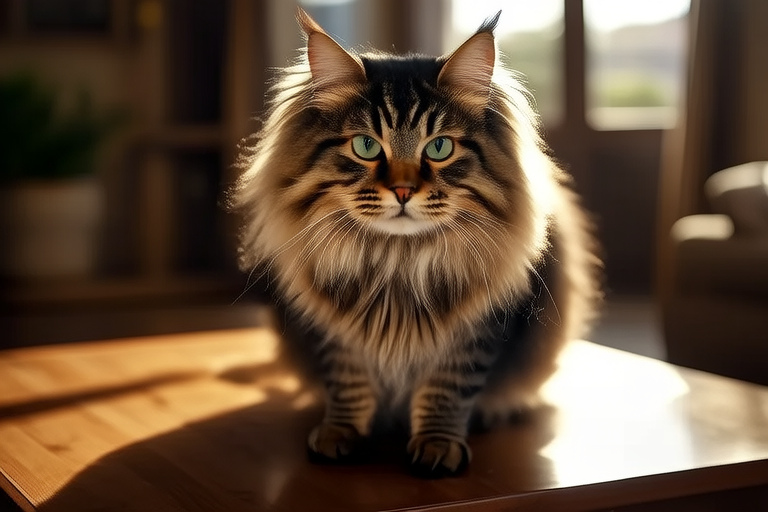Unraveling the Mystery Behind the Maine Coon’s Unique Traits
The Maine Coon is one of the oldest natural breeds in North America, known for its striking appearance and amiable personality. This article delves into the history, physical attributes, behavior, genetic makeup, and popularity of this fascinating feline breed.
History and Origin of the Maine Coon
The origins of the Maine Coon are shrouded in mystery and legend. One popular myth suggests that these cats are descendants of long-haired cats owned by Marie Antoinette, who were brought to the United States during her attempted escape from France. Another tale involves Vikings, where the cats are said to have been companions to the Norse explorers. However, the most plausible theory is that they are descendants of short-haired domestic cats and long-haired breeds brought over by European settlers.
Regardless of their exact lineage, it is widely accepted that the Maine Coon developed naturally in the harsh climate of New England. Their robust build and thick coats made them well-suited for survival in the region’s rugged terrain. The first documented mention of the breed was in the 1860s when a brown tabby namedcoon was exhibited at a show in Boston. Since then, the Maine Coon has gained recognition and popularity both in the United States and internationally.
Distinctive Physical Traits
Size
Maine Coons are renowned for their large size. They are one of the largest domestic cat breeds, often reaching up to 40 pounds or more for males. Females are typically smaller but still substantial, weighing between 8 to 12 pounds. Their size is not just about weight; they also have a muscular build and a broad chest, giving them a sturdy appearance.
Fur
One of the most noticeable features of the Maine Coon is its luxurious, water-resistant double coat. The outer layer consists of long, flowing guard hairs, while the undercoat is dense and soft. This coat provides excellent insulation against cold weather. The texture can vary depending on the color and pattern of the cat, ranging from silky to slightly rough. The coat’s length is longer around the neck, creating a ruff, and shorter on the shoulders and back. Tail and ear tufts add to the overall majestic look of the breed.
Tail
The Maine Coon’s tail is particularly distinctive. It is long and bushy, often resembling a fluffy scarf. The tail serves multiple purposes: it aids in balance, acts as a counterweight during leaps, and provides warmth during sleep. The tail is usually adorned with tufts of fur, further enhancing the breed’s regal appearance.
Behavioral Characteristics
Intelligence
Maine Coons are highly intelligent cats. They possess an innate curiosity and problem-solving ability, which makes them excellent companions. These cats are quick learners and can be trained to perform tricks or respond to commands. Their intelligence is complemented by a gentle and patient nature, making them ideal for families with children.
Playfulness
Despite their large size, Maine Coons retain a playful spirit throughout their lives. They enjoy interactive toys and games, especially those that involve hunting or chasing. Their agility and coordination make them adept at playing fetch or jumping through obstacle courses. Maine Coons are known for their love of water, often dipping their paws into sinks or bathtubs, which adds to their playful nature.
Vocal Expressions
Maine Coons are not known for being overly vocal, but they do have a unique way of communicating. Their voice is often described as chirping or trilling, rather than traditional meowing. This sound is softer and more melodic, adding a charming quality to their interactions. Some Maine Coons will engage in conversations with their owners, responding to verbal cues or mimicking sounds.
Genetic Factors Contributing to Unique Features
The genetic makeup of the Maine Coon plays a significant role in their unique traits. The breed’s robust health and longevity are attributed to careful breeding practices that have minimized genetic disorders. Genetic studies have identified specific genes responsible for their large size, luxurious fur, and other distinguishing characteristics. Understanding these genetic factors helps in maintaining the breed’s health and preserving its distinct qualities.
Why Maine Coons Are Popular Pets
Maine Coons are beloved pets due to their friendly demeanor, intelligence, and adaptability. They are social animals that thrive in the company of humans and other pets. Their playful and affectionate nature makes them perfect companions for families and individuals alike. Additionally, their relatively low maintenance grooming needs and minimal shedding make them suitable for households with allergies or limited time for extensive grooming routines.
Myths Surrounding the Maine Coon Breed
There are several misconceptions about the Maine Coon breed. One common myth is that they are prone to obesity, which is not necessarily true. With proper diet and exercise, Maine Coons can maintain a healthy weight. Another misconception is that they require extensive grooming, which is not accurate either. While their coat does need regular brushing to prevent matting, it is manageable with consistent care.
In conclusion, the Maine Coon is a breed rich in history and full of unique traits that set it apart from other cat breeds. From their large size and luxurious fur to their playful and intelligent nature, Maine Coons offer a delightful companionship for pet owners. Understanding their genetic background and dispelling common myths helps in appreciating the breed even more. Whether you are a seasoned cat lover or considering adopting your first pet, the Maine Coon is a breed worth exploring.
